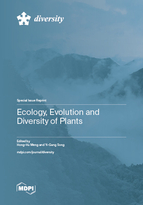Characterization of Okra (Abelmoschus esculentus L.) Accessions with Variable Drought Tolerance through Simple Sequence Repeat Markers and Phenotypic Traits
Round 1
Reviewer 1 Report
The paper by Mkhabela et al is generally well written. Although the use of SSR markers is rapidly being replaced by other genomic technologies, the paper has merit. It makes some useful contribution on Okra’s genetic diversity and how it can be deployed in breeding. Combining both molecular and phenotypic tools in characterizing Okra’s genetic diversity makes the paper particularly interesting. Here are some minor comments that authors need to address
· There is some redundancy in the introduction. The information in line 90-94 is a repetition of what has been stated in the first and second paragraphs of the introduction. This should therefore be revised.
· Line 104 and Table 1: I don’t see any pedigree information in the table.
· Table 1: is there any need of having the column on database since they all indicate the same database. It might make more sense in mentioning the database in the title or as a footnote in the table rather than having a separate column which is highly redundant.
· Line 120: Repetition – you have already stated that DNA was extracted from 20 seeds in line 112. This is again repeated here.
· Line 180: It is important to give more detail on how drought was imposed. Was it partial or complete withdrawal of water supply to the plants?
· Line 222-225: The sentence could benefit from some more punctuation marks to make it easier to read.
· Line 229: Repetition – you have already told us the mean number of alleles (2.70) in line 225
· Line 265-267: sentence is not clear and needs to be revised
· The authors should put more efforts in explaining the clustering pattern obtained through the various methods based on genotypic data. How does the clustering pattern obtained using the various methods compare? Are there any similarities/differences? How do you explain the observed clustering patterns e.g. is there any relationship between the geographical origin of the samples and the observed clustering patterns?
· Line 336: delete the word for- including for
· Line 336: I suggest you replace the word “water condition” with “water(ing) regime” to make it more clear to readers.
· Line 396: accession genotypes – using both of these terms is very confusing. You need to use either accession or genotype depending on the context but not both.
Author Response
Please see the attachment
Author Response File: ![]() Author Response.docx
Author Response.docx
Reviewer 2 Report
The manuscript describes the study of the genetic resources of okra, an important crop plant in certain regions of the world. The research is described very well, and the structure of the work is well laid out. The introduction provides information about the plant and describes its importance, problems related to cultivation, and the current level of research. The research methodology is described in detail and chosen in accordance with the stated goal. The results are presented well, and comprehensibly, and a discussion is provided for them.
The manuscript could be further improved by adding additional results analysis:
- for a better representation of the data, it would be good to compare the results of PCA and cluster analysis of molecular markers, whether there were any regularities.
- justify a little why two cluster analyzes were used and what each of them revealed better.
- to compare the results of molecular markers and morphology, and whether there were any regularities.
- why cluster analysis was not used to analyze morphological data (for comparison with mol data).
These suggestions are not critical, but would certainly improve the quality of the manuscript. Some small notes are also given in the attached file.
Comments for author File: ![]() Comments.pdf
Comments.pdf
Author Response
Please see the attachment
Author Response File: ![]() Author Response.docx
Author Response.docx





